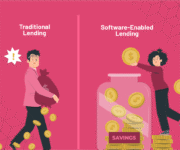Peer-to-peer lending (P2P lending) is disrupting the traditional financial framework, but not without raising concerns about regulatory oversight and borrower-lender protections.
Unlike regulated banks, which must adhere to the strict RBI guidelines for documentation, credit assessment, and compliance, P2P platforms often operate with minimal requirements.
While seemingly beneficial for quick access to funds, this relaxed approach creates substantial risks for lenders. Issues such as unreliable credit data, lack of standardised recovery methods, cybersecurity vulnerabilities, and complex cross-border transactions add layers of risk that could undermine lender confidence and market stability.
This article explores the main challenges P2P financing poses to traditional RBI regulations and the potential impact on the sector’s sustainability.
What is P2P Lending?
Peer-to-peer lending is a form of direct lending of money to individuals or businesses without any involvement of official financial institutions.
These services use digital platforms to manage the loan application process online, including fund transfers.
Over the last decade, P2P lending has averaged an annual return of 7.36% for investors.
It is often a more accessible funding source than conventional loans from financial institutions, especially for borrowers with low credit ratings and atypical loan purposes. It also provides higher returns for investors.
How P2P Lending Challenges RBI’s Traditional Lending Regulations
Despite its benefits, let’s understand how P2P lending is challenging traditional lending regulations by RBI:
1. Bypass Intermediaries
The traditional lending sector has regulated intermediaries (like banks and NBFCs) in place to ensure strict compliance with customer protection norms and market regulations. It provides a structured and objective credit evaluation process.
P2P lending connects borrowers and lenders directly without any intermediary. This makes credit more accessible but makes the process more non-transparent and risky.
2. Reduced Documentation
RBI mandates extensive documentation for traditional lending. It includes proof of income, credit history, know-your-customer (KYC) verification, etc.
P2P lending, on the other hand, allows for quick onboarding with minimal documentation, increasing their attractiveness to borrowers.
The reduced paperwork comes at the cost of the reliability of credit data. It heightens risks for lenders, including increased risk of credit defaults and operational challenges.
For example,
In August 2024, the RBI penalised LenDenClub and LiquiLoans for concealing borrower details from lenders and disbursing loans without individual lender approval.
3. Flexible Interest Rates and Terms
RBI does not directly fix interest rates for traditional lending loans but gives guidelines such as Marginal Cost of Funds based Lending Rate (MCLR) for the fair and reasonable pricing of interest rates.
P2P lending platforms assess borrower creditworthiness, typically categorising borrowers into risk grades based on factors such as credit scores, income verification, and bank statements. While some investors might be attracted to higher interest rates associated with riskier borrowers, financial experts caution against this approach.
Additionally, lending to lower-grade borrowers (often rated D to F) can offer interest rates of 20-25%, but this comes with significantly higher default risks.
4. Minimum Collateral Requirements
Traditional lending typically provides asset-based lending, and RBI has provided stringent guidelines. Priority sector loans like agriculture may have lower collateral requirements, while high-risk loans often require high-value collateral. It helps in minimising the risk of defaults.
A significant share of P2P financing is unsecured lending. It relies solely upon the perceived creditworthiness of the borrower. It increases the risks of defaults, destabilising the sector and negatively impacting investor confidence.
5. Absence of Standard Recovery Mechanism
RBI provides a structured recovery framework like the SARFAESI Act, Insolvency and Bankruptcy Code (IBC) and Debt Recovery Tribunals (DRTs) to help manage unpaid loans in a traditional lending framework.
However, no such standardised system exists in P2P lending, often challenging debt recovery.
For instance, Faircent, a P2P platform, has an in-house debt recovery system. Unlike the SARFAESI or IBC frameworks, these practices don’t carry legal authority and rely mostly on soft recovery methods.
6. Cybersecurity Concerns
RBI mandates traditional lenders to implement stringent cybersecurity frameworks in compliance with the IT Act and the Digital Personal Data Protection Act to protect customer privacy and sensitive information.
P2P lending platforms have no such stringent obligations and often don’t implement rigorous measures.
Since the operations are entirely digital, such challenges make them more vulnerable to data breaches, phishing and unauthorised transactions.
7. Complex Cross-Border Transactions
Any financial transaction involving foreign entities, as per FEMA guidelines, must be processed through RBI-approved channels (banks or registered financial institutions). It ensures that foreign currency flow is appropriately tracked and monitored.
P2P platforms may bypass FEMA’s strict currency controls by allowing foreign individuals or institutional investors to lend directly to borrowers in India without proper due diligence and going through regulatory channels. It raises concerns about illegal transactions and tax evasion.
8. Alternative Data for Credit Scoring
Traditional lenders primarily rely on standardised scores from registered credit agencies. CIBIL, Experian, etc., use verified credit histories to assess the creditworthiness of the borrowers.
Instead of relying on traditional credit scoring methods, P2P lending uses data points ranging from mobile phone usage (call frequency, data consumption, etc.) to social media activity (connection, purchases, etc.), along with AI algorithms.
This method is more inclusive, but it lacks standardisation. There is little oversight on how data is verified, leading to potential issues with the accuracy and fairness of credit scores.
9. Capital Adequacy Requirements (CAR)
For commercial banks, RBI stipulates a CAR of at least 9% and 15% for NBFCs to ensure they have sufficient funds available to meet any losses and protect the stakeholders’ interests.
P2P lending does not lend its capital to borrowers; it only provides the infrastructure and technology.
Hence, even though the risk of lending is real and present, P2P platforms might not be prepared to absorb losses in case of loans facilitated through the platform default. The entire risk falls upon lenders, and the frequent defaults may hamper the trust in the entire sector.
10. Reporting and Audits
There are provisions of regular audits, financial reporting and compliance checks for monitoring the health and transparency of traditional lending institutions by RBI.
For example, quarterly financial disclosures, annual audits, asset quality reviews, etc.
RBI’s Lending Directions, 2017 requires P2P lending platforms to maintain certain basic requirements like funds raised, the number of lenders and borrowers, and overall loan portfolio statistics.
However, the regulatory framework is relatively lenient and not comprehensive. Further, the absence of an independent audit mechanism weakens accountability.
The Takeaway
RBI, by being proactive and adaptive, can foster a regulatory environment that, along with embracing innovation, will safeguard all stakeholders’ interests.
Lending lifecycle management platform and credit evaluation services platform Finezza’s Loan Origination System is built to improve lending and borrowing experiences. It promotes transparency throughout the lending lifecycle.
Also, Finezza’s automated document identification, credit analysis tools, and analytics suite can transform your loan management.




Leave a Reply